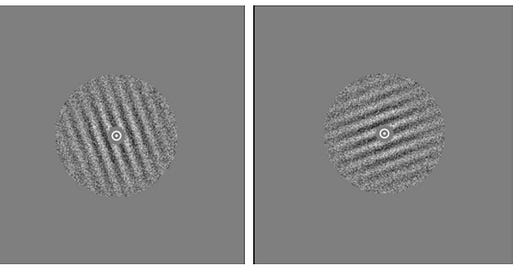We all have behavioural biases that influence our investment decisions. And until now I, like pretty much everyone else, thought that these behavioural biases are ‘all in our heads’: a product of our brain. But researchers from ETH Zurich and the University of Zurich have now shown something mind-blowing: Biases are not just created in our head, but much earlier. It all starts in our eyes.
To come to this conclusion, the researchers performed a simple experiment to elicit confirmation bias with 86 volunteers. To repeat, confirmation bias our tendency to ‘see’ things in such a way that they confirm our goals and previously held beliefs while ignoring or downplaying information that contradicts them.
In the experiment, the volunteers were shown a series of ‘Gabor patches’. Gabor patches are simple patterns of parallel lines that can be rotated. Over several rounds, the participants had to compare two Gabor patches and tell which one showed lines that were closer to a 45-degree angle.
An example of Gabor patches
Source: Brown University
In the first round, the volunteers played this simple game and were awarded 15 points for every correct answer. Then, after a pause, in a second round, the volunteers were asked to compare Gabor patches again but were awarded an increasing number of points for every correct answer starting with 0 points and increasing to 45 points. Crucially, the volunteers were shown exactly the same pairs of patches in exactly the same order, so they effectively did the same task twice but with a different scoring system.
If people are unbiased, the results should have been the same in both rounds and not depend on the scoring system. Yet, in the second round with the variable scoring system, participants unconsciously adjusted their perceptions to score as many points as possible. In a sense, their accuracy improved as the stakes improved.
Ok, so far so unsurprising. Or rather, if you are surprised by these results, you need to learn more about behavioural finance.
Now on to the mind-blowing bit.
So far, the experiment only showed that human perception is biased towards achieving the goal of the person. To tease out whether this bias is created in the brain or already in the retina when it collects the light and transforms it into electrical signals for the brain, the researchers did something really clever.
A group of volunteers repeated the experiment with the variable score. This time, the position of the head was fixed and in the first round, the volunteers decided between pairs of Gabor patches that were displayed in the upper half of their visual field. Again, for every correct answer, they scored an increasing number of points.
Then, in a second round, the same volunteers were shown the same set of Gabor patches in the same order with the same scoring system. But this time, the patches were alternately shown in the upper half of the visual field and the bottom half of their visual field.
Note that in the first round, the volunteers had been training in the upper half of the visual field but not in the bottom half. By comparing the visual perception of the Gabor patches shown in the top half vs. the bottom half, the researchers could identify if perception of the same picture (and with the same reward system) changes when it is shown in a different place.
And guess what? For the patches shown in the upper half of their visual field, the volunteers acted in a biased way that maximised their scores. For the pictures shown in the bottom half of their visual field, this bias disappeared even though the same pictures were shown, and the same points could be earned.
Together with brain images this experiment strongly indicates that biased perception is not just formed in our brain. In fact, what seems to happen is that the retina in our eye already acts in a biased way and selects only the information it finds useful and encodes this into nerve signals sent to the brain!
What this means is that our brain doesn’t have a choice but to be biased. And it means that there is no way to un-train our brain from our biases (at least in this particular case). If the brain isn’t provided with objective information about its environment, how is it ever going to make an objective assessment? We literally can’t be objective because we don’t even perceive the world in an objective manner, let alone analyse it objectively.
And if your mind isn’t blown by that, I put it to you that you have perceived this information in a very biased way. 😊





The Duchess knew it in the 19th century already: Beauty is in the eye of the beholder. 😜
My mind isn’t blown — it’s actually kind of comforting in a told-you-so kind of way. Or rather told-me-so. I’ve been an amateur student of biases for years. As such, I’ve been more than averagely aware of some of the sources of my systematic mistakes. And yet I continue to repeat them. I’ve long theorised that this is because biases are formed much deeper in our mental subsystems than the conscious top layer. Nice to be able to point to some proof! Thank you for highlighting it.